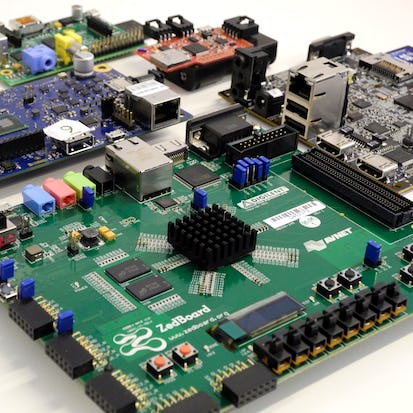- Level Professional
- المدة 17 ساعات hours
- الطبع بواسطة EIT Digital
-
Offered by

عن
This course is intended for the Bachelor and Master's students, who like practical programming and making IoTs applications! In this course, we will talk about two components of a cyber-physical system, namely hardware and operating systems. After completing this course, you will have knowledge of both hardware components and operating systems. You are able to plan and use embedded operating systems in resource-constraint devices for Internet-of-Things (cyber-physical system) applications. In addition, you can use Cooja simulation for designing and simulating wireless sensor network applications. The course offers 4 modules, each with a graded quiz in the end and finally, one peer-reviewed programming assignment. In case you have no experience with C programming, please check a practical course like: https://www.coursera.org/learn/arduino-platform. The course is actually quite fun at the end when you play around with Cooja simulation for IoTs applications. So you can create and simulate your own design for sensor network applications. A lot of features and examples of Contiki and Cooja can be explored via assignments. There are some optional assignments of wireless sensor network applications for students who want to explore more about embedded OS in IoTs applications. - Marco Ramirez /University of Turku - Igor Tcarenko/ University of Turku - Nguyen Gia Tuan /University of Turku Check out our whole curriculum: http://iot4health.utu.fi/الوحدات
Course Introduction
1
Videos
- Introduction
Introduction to Embedded Hardware
2
Videos
- Introduction to Embedded Systems
- Design characteristics and challenges
Input/Output
3
Videos
- Input/Output devices
- Wire communication, ADC/DAC
- Sensors, actuators, interrupts vs. polling
4
Readings
- Build your own input/output system with the Arduino!
- Build your own ADC using Arduino!
- Learn how to use serial communication using the Arduino!
- Create a timer for polling using the Arduino!
Assignments and Forums
1
Assignment
- Introduction to Embedded HW (Graded quiz)
1
Discussions
- Module 1 Discussion
1
Readings
- Quiz 1 assignment (to be done before Quiz 1)
CPUs and FPGAs
2
Videos
- Embedded processors and FPGAs
- Main features of embedded processors
Use-cases
3
Videos
- Use-cases of micro-controller platforms
- Reconfigurable platforms, FPGAs
- Embedded processors vs. FPGAs
2
Readings
- Practical list of comparison of MCU vs FPGA
- A comparison between MCU, FPGA, DSP, ASIC from Atmel
Assignments and Forums
1
Assignment
- Processing elements (Graded quiz)
1
Discussions
- Module 2 Discussion
Introduction to Embedded Operating Systems
1
Videos
- Module 3 Lecture1: Embedded operating systems
Operating System Kernels
3
Videos
- Linux kernel functions and advantages
- The microkernel
- The modular kernel
1
Readings
- In depth reading of the QNX microkernel
Hands-on
1
Peer Review
- Honors Assignment: TinyOS -- Hands-on
3
Videos
- Introduction to Contiki
- Introduction to TinyOS
- Introduction to RIOT OS
3
Readings
- The case for using Contiki in sensor networks
- TinyOS github & Documentation
- RiotOS for IoT
Assignments and Forums
1
Assignment
- Embedded Operating Systems (Graded quiz)
1
Discussions
- Module 3 Discussion
Contiki
7
Videos
- Contiki and Cooja simulation
- The Contiki system
- Contiki's kernel architecture
- Contiki services and libraries
- Communication in Contiki I
- Communication in Contiki II
- Protothread, multithreading and code sizes
Cooja Simulation
1
Videos
- Cooja simulation
1
Readings
- Get started with Cooja: Step-by-step
Assignments and Forums
1
Assignment
- Contiki and Cooja (Graded quiz)
2
Peer Review
- Contiki Hands-on
- Energy consumption estimation
1
Discussions
- Module 4 Discussion
Auto Summary
Discover the essentials of Embedded Hardware and Operating Systems in this dynamic IT & Computer Science course. Led by experts Marco Ramirez, Igor Tcarenko, and Nguyen Gia Tuan from the University of Turku, you'll delve into the intricacies of cyber-physical systems, focusing on hardware and operating systems tailored for IoT applications. The course comprises 4 engaging modules, each ending with a graded quiz, plus a peer-reviewed programming assignment. Ideal for professional-level learners, it offers hands-on experience with Cooja simulation for wireless sensor networks. Available on Coursera with flexible subscription options.

Farhoud Hosseinpour

Nguyen Gia Tuan


